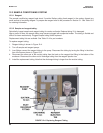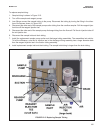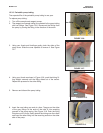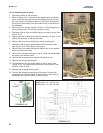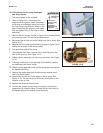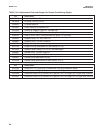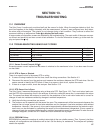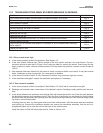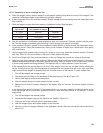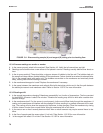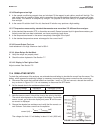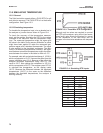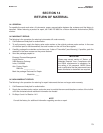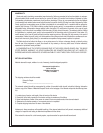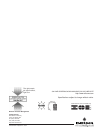
69
MODEL TCL SECTION 13
TROUBLESHOOTING
13.3.3 Sensitivity is low or readings are low
A. Does the reagent carboy contain reagent? Is the reagent uptake tubing below the level of the reagent? Has
potassium iodide been added to the acetic acid (vinegar) reagent?
B. Is there adequate flow to the overflow sampler? Excess sample should be flowing down the inside tube of the
flow controller.
C. Does the reagent contain the correct amount of potassium iodide? See the table.
D. Was the comparison or calibration sample tested as soon as it was taken? Chlorine solutions can be unsta-
ble. Test the sample immediately after collecting it. Avoid exposing the sample to sunlight.
E. Is the membrane fouled or coated? A dirty membrane inhibits diffusion of iodine through the membrane, reduc-
ing sensor current. Clean the membrane by rinsing it with a stream of water from a wash bottle. Wipe gently
with a soft tissue.
F. Are the reagent and sample pumps running? If a pump is not running, check the fuse and replace it if neces-
sary. See Table 12-4 for part numbers. If the fuse is okay, replace the pump.
G. Are all tube fittings tight? Pay particular attention to the luer fittings that connect the tubing to the pumps.
H. Does the pump tubing element need replacing? Remove the tubing from the pump and inspect it. If the tubing
appears permanently pinched or deformed, replace the tubing. Refer to Section 12.3.4 for instructions on how
to remove and replace the tubing elements. The expected life of a tubing element is about one year.
I. Is the sample flow to the sensor about 11 mL/min? If the sample flow is too low, the total chlorine reading will
be low. If the flow is too high, the ratio between the sample flow and reagent flow will be too high, and there
might be insufficient reagent to properly react with the total chlorine in the sample. To check sample flow…
1. Turn off the reagent and sample pumps.
2. Disconnect the luer fitting on the discharge of the sample pump. See A in Figure 13-1.
3. Hold a small beaker under the discharge port.
4. Start the sample pump and collect sample for two minutes.
5. Measure the volume of sample collected in the beaker. After two minutes, the volume should be about
22 mL.
J. Is the reagent flow about 0.2 mL/min? If the reagent flow is too low, there might be insufficient acetic acid to
lower the sample pH and insufficient potassium iodide to react with total chlorine in the sample. To check
reagent flow…
1. Turn off the reagent and sample pumps.
2. Disconnect the reagent tubing at the injection tee. See B in Figure 13-1.
3. Place the end of the tubing in a 5 mL graduated cylinder.
4. Start the reagent pump and collect reagent for ten minutes.
5. Note the volume of reagent collected in the graduated cylinder. After ten minutes the volume should be
about 2 mL.
Expected range, Amount of KI needed Part number
ppm as Cl2 per 5 gallons of vinegar
0 – 5 ppm 25 grams 24164-00
0 – 10 ppm 50 grams 24164-01
0 – 20 ppm 2 x 50 grams 24164-01



